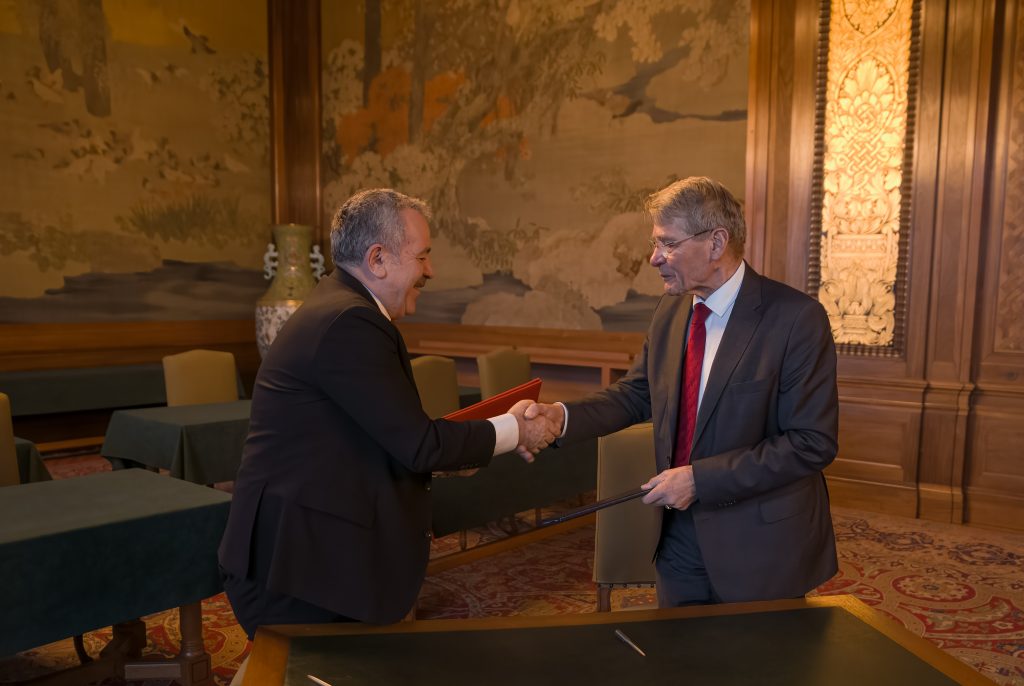24-01-2023
The Peace Palace in The Hague houses what is probably the largest Hereke carpet outside Türkiye. For more than 112 years the carpet has been part of the inventory of the Palace. For the first time it will be leaving the Palace for reasons of restoration in its place of origin. This requires not only the best craftsmen in the field, but also good cooperation and complex logistics to restore this 160 m2 cultural treasure.

The Peace Palace in The Hague, Netherlands, is the worldwide symbol of peace through justice. It opened its doors in 1913 and has served the ideal of “Peace through Law” ever since. Today, it houses the Permanent Court of Arbitration, the United Nations International Court of Justice, The Hague Academy of International Law and the Peace Palace Library.
In 1907, when the first stone of the Peace Palace was laid, countries were asked to contribute to the construction of the Palace. Over 40 countries responded to this call, donating works of art such as paintings and vases, or building materials such as wood and marble. In this way the Peace Palace is not only a place for the world, but also from the world.
In 1911, the Ottoman Empire donated the Hereke carpet to the Peace Palace. This carpet is named after its place of origin, the town Hereke in Türkiye, and with its 160 m2 the carpet in the Peace Palace is said to be the largest Hereke carpet outside of Türkiye. It has a distinctive typical geometrical Hereke pattern and is made of the characteristic Turkish “Gördes” knot. The carpets from Hereke are worldwide known for their extraordinary quality and craftsmanship.
The carpet in the Peace Palace decorates the floor of one of the most stately rooms of the Palace, the Japanese Room. Many conferences and hearings, especially of the Permanent Court of Arbitration, are hosted in this room. Although Hereke carpets are known to be long lasting and durable, the Hereke carpet in the Peace Palace is obviously in need of restoration, due to the intensive use of this conference room. Since the Peace Palace received the carpet more than a century ago, it has never been fully repaired or restored.
The Carnegie Foundation, owner and manager of the Peace Palace, asks the countries that gave works of art or building materials for the construction of the building to also support the maintenance and restoration of these objects in this day and age. By doing so, countries demonstrate that they are still supporting the work of the Courts and the purpose of the Palace. In this context, the Turkish Ministry of Culture and Tourism has made the offer to restore the carpet by specialists in Türkiye.
Today the protocol on the terms and conditions of this restoration has been finalized in the presence of the Turkish Ambassador H.E. Şaban Dişli. The Chairman of the Carnegie Foundation, Mr. Piet Hein Donner, signed the protocol which was previously signed by the Deputy Minister of Culture and Tourism of the Republic of Türkiye, Mr. Nadir Alpaslan, on behalf of the Turkish side.
The Hereke carpet is expected to be collected from the Peace Palace in the spring of 2023. After a basic cleaning by a Dutch company, it will be transported to Sultanhanı in the Turkish province Aksaray, to be restored by the Turkish Ministry of Culture and Tourism and a team of experienced craftsman there. This highly skilled team with decades of expertise has also restored carpets for Buckingham Palace in London, among others.
Mr. Donner, chairman of the Carnegie Foundation: “The Hereke carpet is a unique piece of craftsmanship, and I am glad that this cultural heritage will be preserved for future generations. Together with the other works of art, this carpet daily reminds the staff working at the Peace Palace of their work’s purpose: Peace through Law.”
H.E. Şaban Dişli, Ambassador of Türkiye: “We are excited to be able to make this contribution, and confident that the restored carpet will continue to symbolize our very special relations and history for many years to come.”